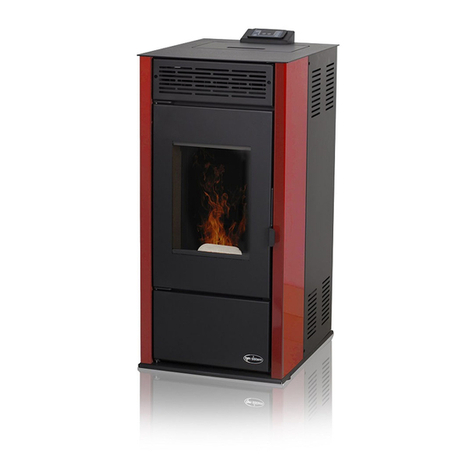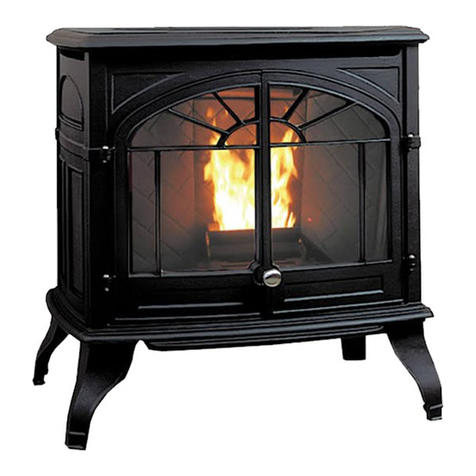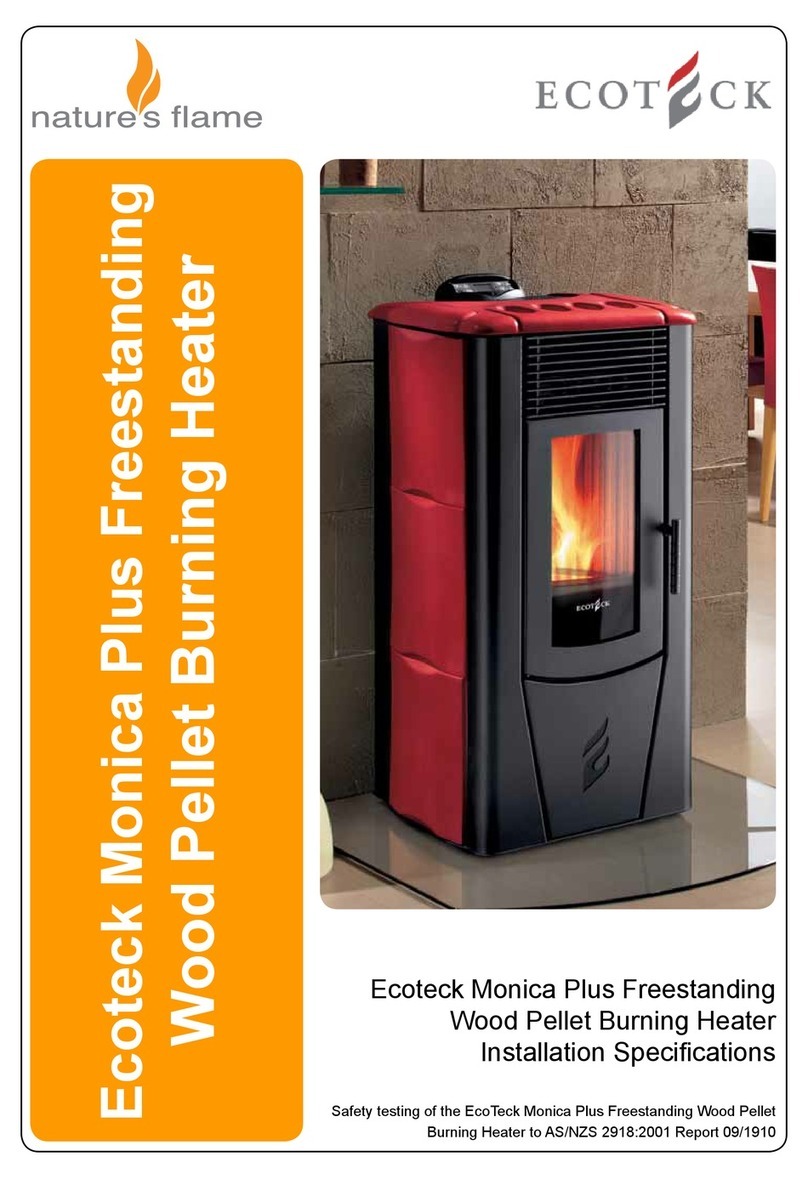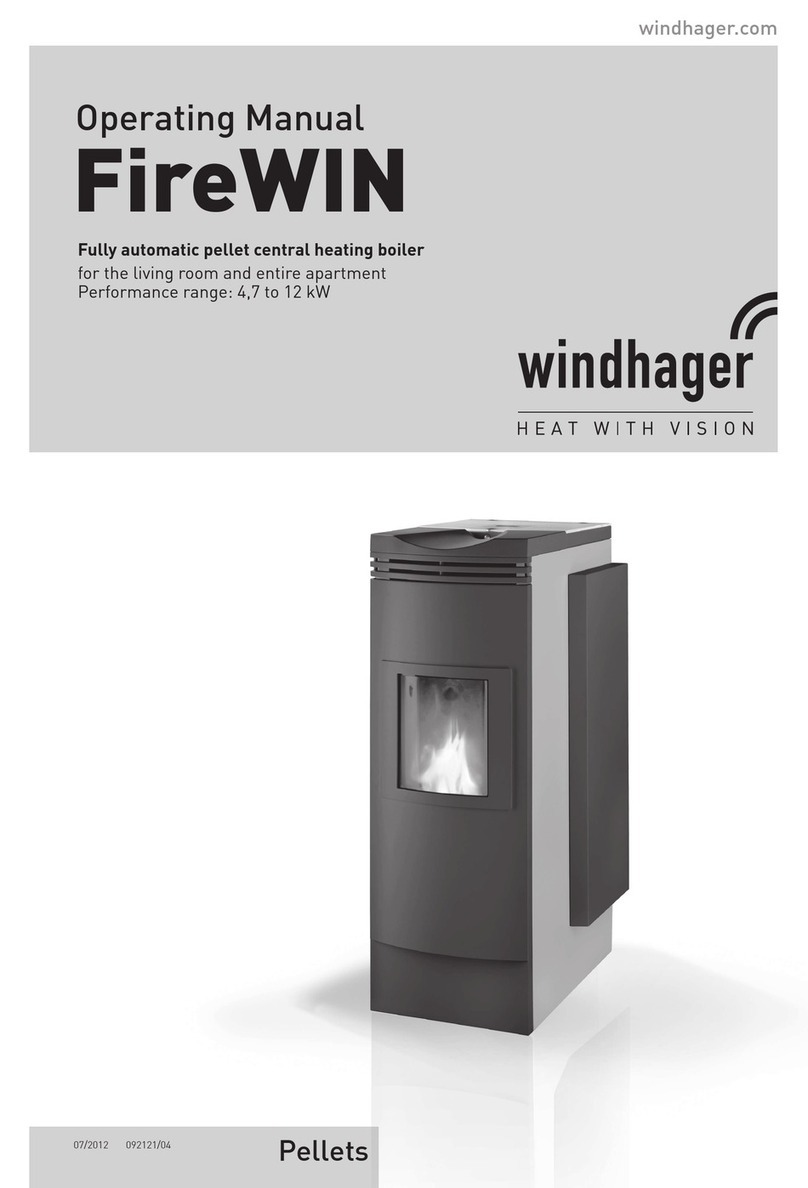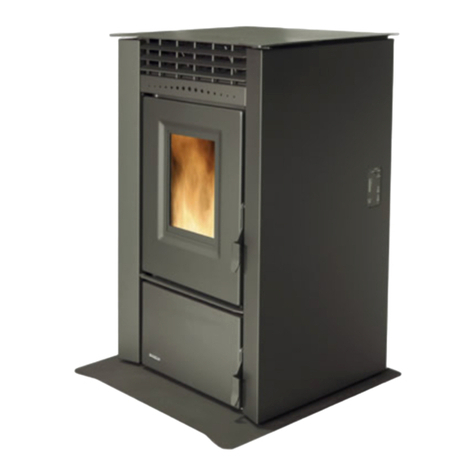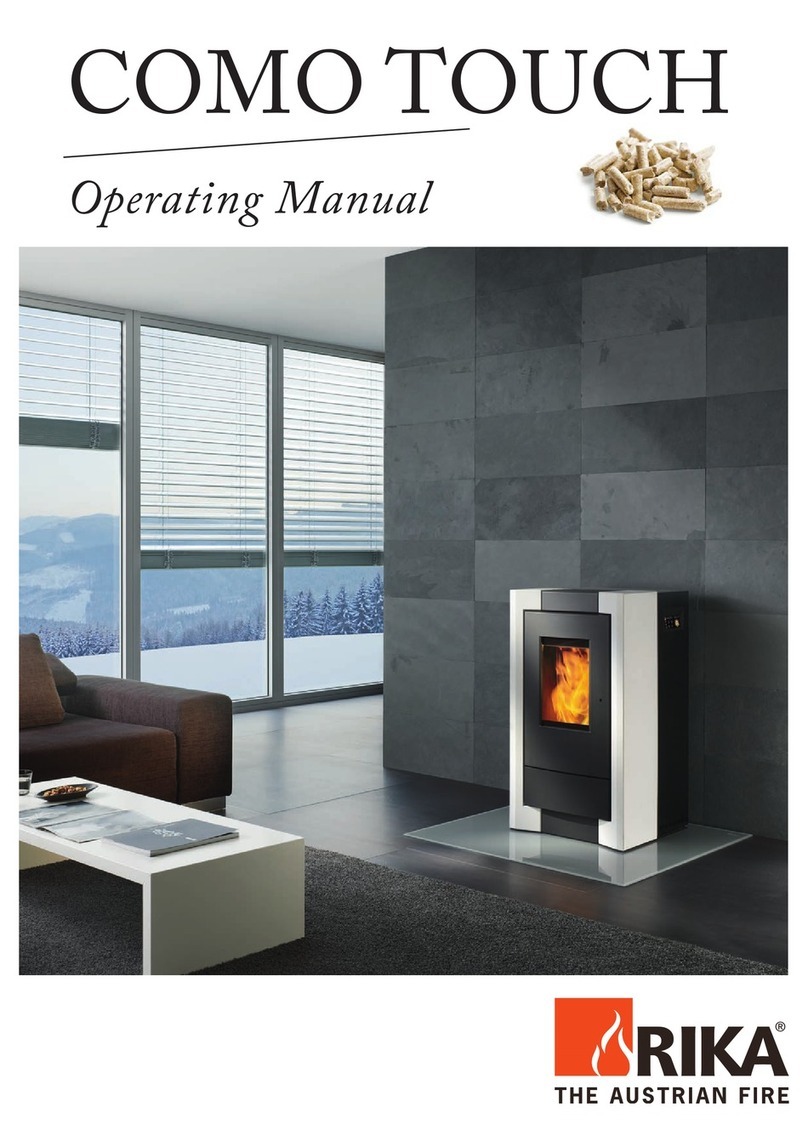Tim Sistem RITTIUM 7 User manual

RITTIUM 7 pellet stove
Owner’s manual
INSTALATION, OPERATING AND MAINTENANCE INSTRUCTION
Available in ceramic and metal sheet version.
* * * ceramic top plate version
EN 14785:2006


1.
1.1
2.
3.
4.
5.
6.
6.1
6.2
7.
7.1
7.2
8.
8.1
8.2
8.3
8.3.1
8.3.2
8.3.3
8.3.4
8.4
8.5
8.6
8.7
8.8
8.9
9.
10.
11.
12.
CONTENTS
About pellet . . . . . . . . . . . . . . . . . . . . . . . . . . . . . . . . . . . . . . .
Quality of pellet . . . . . . . . . . . . . . . . . . . . . . . . . . . . . . . . . . . .
REMARKS BEFORE OPERATING THE STOVE . . . . . . . . . .
TECHNICAL SPECIFICATIONS . . . . . . . . . . . . . . . . . . . . . . .
BASIC FEATURES OF THE STOVE . . . . . . . . . . . . . . . . . . .
INSTALATION OF THE STOVE . . . . . . . . . . . . . . . . . . . . . . .
DISPLAY AND REMOTE CONTROL . . . . . . . . . . . . . . . . . . .
Symbols of basic elements of the stove . . . . . . . . . . . . . . . . .
Remote control . . . . . . . . . . . . . . . . . . . . . . . . . . . . . . . . . . . .
USE OF THE STOVE . . . . . . . . . . . . . . . . . . . . . . . . . . . . . . .
Turning on and turning off the stove . . . . . . . . . . . . . . . . . . .
Temperature and mode settings . . . . . . . . . . . . . . . . . . . . . . .
SETTINGS . . . . . . . . . . . . . . . . . . . . . . . . . . . . . . . . . . . . . . .
Blower settings (optional) . . . . . . . . . . . . . . . . . . . . . . . . . . . .
Clock settings . . . . . . . . . . . . . . . . . . . . . . . . . . . . . . . . . . . . .
Timer settings . . . . . . . . . . . . . . . . . . . . . . . . . . . . . . . . . . . . .
How to turn the timer on . . . . . . . . . . . . . . . . . . . . . . . . . . . . .
Daily programmer . . . . . . . . . . . . . . . . . . . . . . . . . . . . . . . . . .
Weekly programmer. . . . . . . . . . . . . . . . . . . . . . . . . . . . . . . . .
Weekend programmer . . . . . . . . . . . . . . . . . . . . . . . . . . . . . . .
Language settings . . . . . . . . . . . . . . . . . . . . . . . . . . . . . . . . . .
STAND-BY mode. . . . . . . . . . . . . . . . . . . . . . . . . . . . . . . . . . .
Sound-alerts . . . . . . . . . . . . . . . . . . . . . . . . . . . . . . . . . . . . . . .
Initial pellet loading . . . . . . . . . . . . . . . . . . . . . . . . . . . . . . . . .
Operation. . . . . . . . . . . . . . . . . . . . . . . . . . . . . . . . . . . . . . . . . .
Technical settings . . . . . . . . . . . . . . . . . . . . . . . . . . . . . . . . . .
OPERATION INFO . . . . . . . . . . . . . . . . . . . . . . . . . . . . . . . . .
POTENTIAL ERRORS IN OPERATION . . . . . . . . . . . . . . . . . .
CLEANING AND MAINTAINANCE. . . . . . . . . . . . . . . . . . . . . .
WARRANTY . . . . . . . . . . . . . . . . . . . . . . . . . . . . . . . . . . . . . . .
ENCLOSURE. . . . . . . . . . . . . . . . . . . . . . . . . . . . . . . . . . . . . . .
4
4
5
6
7
8
10
10
11
13
13
14
15
15
16
17
17
18
20
23
25
26
27
27
28
29
30
31
35
36
37
3

1. ABOUT PELLET
Pellet is an energy fuel with high energy efficiency, which is produced in special
technological process of milling, drying and pressing of various materials of biological
origin. As raw materials for its production can be used wood from forestry waste,
firewood, sawdust and other wood waste (wood pellets); the straw of wheat and
soybeans, corn and sunflower husks (agro pellets).
Nowadays, when the accent has been put on environmental protection and
sustainable development, fuels produced from biomass are increasingly gaining in
importance.
Using pellets as a fuel material has multiple advantages either for the
environment or, at the first place, for a customer itself:
•
Using one ton of pellets, for the same heating quantity, replaces 500 liters
of heating oil, or 450 kg of propane-butane, or 600 cubic feet of natural
gas, or 4800 kilowatt-hours of electricity;
It significantly reduces emission of harmful gases, such as: carbon
dioxide, sulfur dioxide and mercury, and the burning leaves only 0.5 - 1%
of ash;
Wood pellet is made of 100% natural materials and contains no added
binders, chemicals or additives;
Compared with other fuels or using electricity, the use of pellets is much
more cost-effective;
Pellet takes up far less space than coal and firewood.
•
•
•
1.1 Quality of pellet
The quality of pellets is of great importance for the stove. If the pellet is
substandard and inadequate in size, it can bring to a poor performance of the stove.
Here are some advices on how to choose and store pellets:
•
•
•
•
•
•
•
•
diameter of the pellets should be 6 mm and length about 30 mm;
use only wood pellets;
pellet should be cylindrical;
good quality pellet should quickly sink when thrown into a glass of water;
pellet is not adequate when in a bag of pellets you find a lot of dust or friable;
a pack of pellets should be hermetically sealed, because pellets absorbed
humidity;
humidity must be less than 10%;
pellets are supposed to be stored in dry, well ventilated room, out of the reach
of flammable elements or devices which during operation create a high
temperature
4

2. REMARKS BEFORE OPERATING THE STOVE
Always follow the references given in this chapter. The manufacturer doesn’t
take a responsibility for consequences in opposite cases. Not respecting the
instructions of use and maintenance, you lose your right to a warranty.
•
•
•
•
•
•
•
•
•
•
before operating the stove, please read this manual;
stove is used exclusively for heating;
keep the stove away from flammable materials;
keep the stove in dry places;
keep the children or pets away from the stove, because some parts emits
high temperatures and they can cause burns;
do not touch the parts that emit a high temperature, such as smoke drain,
glass, fire door, the side;
for heating use only a pellet which was originally made of wood;
stove should be cleaned only when it is cold (the stove is completely cooled
after 30 minutes after turning off the stove);
stove should be cleaned only when it is disconnected from the power source
on the main switch (Chapter: basic parts of the stove);
in the room where stove is placed, it is necessary to ensure a permanent
supply of fresh air;
stove must be installed in accordance with these manual (Section: stove
installation)
Stove and its packaging are made of materials that can be recycled. Stove,
which is not in use any more, should be put away in an adequate place or else you
should call the service for waste disposal. You must act according to a regulation in
force in the country where the stove is placed.
For any defect you need to call a qualified technician. All defects must be
removed by an authorized service technician. In case that an unauthorized person
repairs a stove, you will automatically lose a warranty and any further repairs by an
authorized service will be charged.
NOTE: Each stove before packing requires the operation and safety control;
therefore it’s possible to find some burning remains in the firebox. It is also
possible to find a small amount of pellets in the store.
During the first firing can occur some paint burning, therefore it’s
recommended to ventilate the room well after.
5

Power
kW
6 kW
8 kW
10 kW
Dimension (W x L x H)
mm
523 x 603 x 1041
Weight
kg
127
Fuel (dimension)
wood pellet (6 mm L30 mm)
Smoke drain
mm
80
Draft
Pa
12±2
Capacity of a storage
kg
19
Voltage
V
230 ± 15%
Frequency
Hz
50
Electrical power during the operation
W
55 - 160 *
Electrical power during the initialization
W
400 - 450 **
Maximal efficiency
%
87,6
Minimal power
kW
2,87
Nominal use of pellet
kg
1,5
1,9
2,4
Minimal use of pellet
kg
0,8
CO emission reduced on 13%
%
0,0133
Maximal exhaust gas temperature
oC
148
Dust content
mg/m3
45,4
Operating temperature
oC
5 - 60
Storage temperature
oC
-10 - 60
Max. relative humidity (with no condensation)
%
95
* depending of which fan is on, as well as the motor reducer
** lighter and emissions fan is on (400W), while an motor reducer is occasionally getting on
3. TECHNICAL CHARACTERISTICS
Table 1. contains the technical characteristics
Table 1.
6

4. BASIC FEATURES OF THE STOVE
Image 2. Basic features
1. Firebox doors
2. Door handle
3. Door glass
4. Ashtray door
5. Ashtray
6. Combustion pot
7. Front lateral
8. Rear lateral
9. Upper cover
10. Display with commands
11. Storage cover
12. Storage
13. Upper ceramic plate
14. Back side
15. Smoke drain
16. Primary air
17. Main switch
18. Communication port (RS232)
19. Socket
20. Safety thermostat
7

5. INSTALATION OF THE STOVE
With a stove you will get the user’s manual, remote control and power cable.
These accessories , included with the stove are presented on an Image 3.
Image 3. Included accessories
Before you start installation of the stove , you must read carefully instructions for use
and maintenance, get to know well a regional regulations and legislation, in order to
apply them. You must provide enough air in the room where the stove is placed in
order to provide an optimal combustion.
Place the stove as close as possible to a smoke drain, where is also a power
connection. The stove should be away from any possible obstacles, like presented in
Image 4.
Image 4.
Optimal distance
8

Stove should be set 300 mm away from the obstacle on its sides, 300 mm from
the back side, while the front side should be at least 800mm away from obstacles. Do
not place any objects on the stove, because they could be damaged by a high
temperatures that the stove emits.
Under the stove can be set some sheet metal or a thicker glass of, minimal
dimensions 700 x 800 mm, in a way that the front part is longer than the stove itself.
The stove stands on adjustable feet which must be set so that the stove is
stable. Feet are being adjusted by simple unscrewing or twisting.
It is necessary and sufficient to provide sufficient air supplies to the chimney so
that the stove could to function smoothly. The easiest way to check whether the
chimney is working well is to get close to a smoke drain a lighter or a candle flame. If
the flame is vertical as it was before, away from the chimney, then you should check
whether the chimney needs to be cleaned, or is there some other problem in
between. If the flame sways toward the mouth of the chimney, there is quite sufficient
air movement. All irregularities in the functioning of the chimney must be removed
before initializing the stove.
When connecting the stove with smoke drain and flue tubes, check carefully if
all connections are well sealed, so that gases do not to enter the room where the
stove is located. Flue pipe must not be too drawn into the chimney.
With the stove you get and the power cord. Stove is connected to the power
source voltage of 230V and 50Hz. Stove must be connected only to the required
socket. Image 5 shows how the stove is connected to a power source. Before
plugging in the cable, check if the main switch is set to the position 0.Note that the
power cord is not damaged. Cable must be disconnected from the heat source. First,
turn the cable into the stove to the required space and then into a power socket.
Image 5. Connecting the stove to power source
9

6. DISPLAY AND A REMOTE CONTROL
On display there are 6 keys which are being used for managing different functions
of the stove. In the middle, there is a display where is being shown a basic information
about the stove operation.
Image 6. Represents a display
1. Temperature setting keys
2. Main menu entering keys
3. Indicators of the stove parts
4. Time display
5. Room temperature display
6. Modes of operation
7. Current status information
8. On/Off switch, exit key
9. Mode settings keys
10. Sensor of remote control
6.1. Symbols of the basic elements of stove
Next to each symbol, there is the indicator light showing which of the element is
currently on. Beside of the symbols for the pellet, the indicator will be periodically
turned on and off depending on whether the engine for the insertion of pellets is on or
off. Description of symbols is given in Table 2
10

Timer indicator (turning the on and off according to a selected program)
Heater indicator for burning the pellet
Engine for pellet insertion indicator
Emissions fan indicator
Blower indicator
Water pump indicator (this symbol is an optional and it has its
function with a stove for a floor heating)
Warning indicator (the stove operate in incorrect way)
Table 2. Symbols on the display
6.2. Remote control
With a remote control, a battery will not be delivered. In order to use the remote
control, you need do buy a battery of 12V, P23GA type. Image 7 represents a remote
control and a battery.
Image 7. Battery and a remote control (1 –temperature setting buttons, 2 –remote
control indicator, 3 –mode keys, 4 - transmitter, 5 -cover)
Take off the cover and set the battery according to the symbols indicated in the
bottom of the remote. Symbol + goes with a + on the battery.
11

Pressing the buttons 1 and 6 at the same time turns stove ON and OF. Pressing
the buttons 1 and 2 is being set a wanted temperature. Buttons 5 i 6 are there for
mode settings. Settings of temperature and mode are described accurately in the
chapter “USE OF THE STOVE”.
12

7. USING THE STOVE
Follow this guide always, so that the stove remains in good condition as long as
possible and to avoid unnecessary costs. Before initializing the stove, check to see if
the stove is well connected to the power source and the chimney.
To turn on the stove, it is also necessary to change the main switch from position
0 to position 1.
7.1. Turning on and turning off the stove
The stove is being turned on and off on button 4. Keep pressing the button until
on display does not appear START.
When starting the stove display will show the indicators of the elements currently
on. Exhaust fan will run until the stove is turned on, even after turning it off it will
continue running for some more time.
The next displayed message will be LIGHTER WAIT, indicating that the lighter is
on and that it’s being warmed up in order to get the pellets inflamed. Stove will load
the amount of pellets needed for the initialization, which will be followed by a
message LOAD PELLET. The indicator for the insertion of pellets will be on only
when the engine for pellet insertion is on.
Alternately will rotate messages LOAD PELLET and WAIT FIRE until the
temperature of exhaust gases does not exceed 40°C, which is necessary in order to
detect the flame and for stove to start working. The maximum time required to reach
40°C is 25 minutes. There will be displayed a message FLAME LIGHT. When a
flame is detected, the stove shuts down the lighter. Mode will be accompanied by a
message WORK.
13

3 - 4 min.
Periodically stove cleans the pot where the pellet
combustion takes place. This operation is followed by a
message CLEANING FIRE POT. A time that precedes
the cleaning is different depending on the model stove.
When shutting down the stove, you need to press key 4 and keep it that way for
a while, until on display appears the message CLEANING FINAL. Stove will blow
warm air in the room until the fire place has cooled to a temperature of 75oC. After a
while the there will be displayed a message OFF, which means that the stove is
turned off.
7.2. Temperature and mode settings
Temperature setting is done by pressing keys 1 or 2.
Stove will be heated to a certain temperature and then
maintain the same one. Command is done by pressing
the key 1 or 2 briefly after what pressing the same buttons
you set the temperature up and down. This action will be
followed by a message SET ROOM TEMP. The
temperature can be changed in the interval from 7 to
40oC.
Mode setting is done by pressing the key 5 or 6.
Modes can be changed from P1 to P5. Modes can be
changed keys 5 and 6, which will be followed by the
message SET POWER. Higher the mode is faster will be
achieved the desired temperature, after which it will
switch to WORK MODULAT, which means that the stove
has reached the selected temperature that will be
maintained with a lower regime.
14

8. SETTINGS
8.1. Blower settings (optional)
Setting the blowers is possible only in stoves with heat dissipation channel.
Setting can be done either when the stove is on or when it is switched off (main
switch for the power supply on). The setting is being done in a following way:
Press the key 3 (set), after what it will appear a message menu 01 ADJUST
BLOWERS, and then again press the key 3 (set), and a display will show menu 01
VENT-2 0 VENT-3 0. Setting can be done when box is flashing.
For the ventilator 2 is used the key 1, while the for the ventilator 3 is used the key 2.
By pressing the buttons 1 and 2 will be shown a movement of numbers from the far
right side, where the numbers indicate the following:
0
1
2
3
4
5
A
- fan is off
- fan will run with the speed 1
- fan will run with the speed 2
- fan will run with the speed 3
- fan will run with the speed 4
- fan will run with the speed 5
- fan will run with the speed that depends on the mode
The following figure shows an example of fan
setting. fan 2 is set on speed 2, while the speed of
fan 3 automatically changes depending on the mode.
In Figure 1 the indicator blinks, while the indicators 2
and 3 are on. That means that the fan 2 and 3 are
running. Indicators are off when the fan 2 and 3 are
set to 0 (that is, turned off). Setting is completed by
pressing the key 4 twice, after what you’re getting
back on home menu.
15

8.2. Clock settings
Clock setting is being done in following way. Press the key 3 (set), after what
there will be displayed a message menu 01 ADJUST blowers. Then press the key 5
and you’ll be displayed a message menu 02 SET CLOCK; afterwards, press again
the key 3 (set), in order to access the clock setting menu.
The display will show the following message menu 02 and written below will be a
day that is currently set. Lighted setup indicator will start to flash. Pressing the keys 1
and 2 you may change days as it’s shown below:
MONDAY
TUESDAY
WEDNESDA
THURSDAY
FRIDAY
SATURDAY
SUNDAY
After the days in a week, pressing the key 5 settings will change in a following
order: Hour setting, minutes, days in a month, months and years. Parameter setting
are being done by pressing the keys 1 i 2. This is how a display is supposed to look
like.
Hour setting
Minute setting
Day setting
Month setting
Year setting
Pressing a key 6, you can always step back. To exit the clock settings press key 4 twice.
16

8.3. Timer settings
There are three kinds of timer settings:
•
•
•
Daily - allows the stove itself on and off 2 times during the day
Weekly - allows the stove is programmed to be 4 times during the day to
include and exclude seven days a week
Weekend setting - allows the stove twice and switched off during Saturday and
Sunday.
8.3.1. How to turn the timer on
The timer is activated always in the same way no matter which type of the
setting is active (daily, weekly or weekend program). The timer is getting active in a
following way:
Press the key 3 (set), after what a display will show a message menu 01
ADJUST blowers. Then press the key 5 twice and there will be displayed the
message menu 03 SET CHRONO. Pressing the key 3 (set) you will access the timer
setting menu. On display there is a message m-3-1 CHRONO ENABLE. Then again
presses the key 3 (set) and there will appear a message off m-3-1-01 ENABLE
CHRONO, which means that the timer is turned off, and setting indicator will continue
blinking. Pressing the keys 1 or 2 you’re switching the timer from off to on.
x2
After switching the timer on display will show up the indicators that show what
type of programming is active (daily, weekly, weekend) and the indicator next to the
clock symbol which shows that the timer is turned on. Appearance of the signs and
indicators are given in the following figure.
17

1
2
3
4
-
-
-
-
Daily programming indicator
Weekly programming indicator
Weekend programming indicator
Timer indicator
To exit the timer setting press the key 4 twice
8.3.2. Daily programming indicator
NOTE: Make sure that the starting up and shutting down time does not overlap. It is
also necessary to pay attention that between this two processes pass at least 30
minutes.
During the daily programming you can set two starting ups and two shutting downs of
the system.
Press the key 3 (set), afterwards there will be displayed menu 01 ADJUST
blowers. Then press the key 5 twice to get the message menu 03 SET CHRONO.
Pressing the key 3 (set) you access the timer setting menu, and consequently in the
menu foe turning the timer on. On display will show ENABLE 1 CHRONO. Then
again presses the key 5 and the on display will show up the message m-3-2 DAY
PROGRAM.
x2
Afterward, pressed the key 3 (set) and there will be displayed m-3-2-01
CHRONO DAY. With the keys 1 and 2 switch the on command, in order to activate a
daily timer. Use the keys 5 and 6 to scroll through menus, and the keys 1 and 2 to
change the parameters. The menu is shown in the following table. Time can be set in
intervals of 10 minutes.
.
18

MENI
SETING OPTIONS
DISPLAY APPEARANCE
m-3-2-01 CHRONO DAY
off/on
m-3-2-02 START 1 DAY
off/00:00-23:50
m-3-2-03 STOP 1 DAY
off/00:00-23:50
m-3-2-04 START 2 DAY
off/00:00-23:50
m-3-2-05 STOP 2 DAY
off/00:00-23:50
To exit the settings press the key 4 twice.
SETTING EXAMPLE: The stove is starting up at 6 am and turning off at 8 am, the
next starting is at 2 pm and turning off in 10:30 pm. Parameters need to be set
according to a following table.
m-3-2-01 CHRONO DAY
m-3-2-02 START 1 DAY
m-3-2-03 STOP 1 DAY
m-3-2-04 START 2 DAY
m-3-2-05 STOP 2 DAY
ON
06:00
08:00
14:00
22:30
19

8.3.3. Weekly programming
NOTE: Make sure that the starting up and shutting down time does not overlap. It is
also necessary to pay attention that between this two processes pass at least 30
minutes.
During the daily programming you can set four starting ups and four shutting
downs of the system. Also you may set the activation of the specific program for a
specific day.
Press the key 3 (set) and you will get a displayed message menu 01
ADJUST BLOWERS. Afterward you need to press the key 5 twice, and on display
will be written menu 03 SET CHRONO. Pressing the key 3 (set) you access the timer
setting menu, and consequently in the menu for turning the timer on. On display will
show up ENABLE 1 CHRONO. Then again presses the key 5 twice and the on
display will show up the message m-3-3 PROGRAM WEEK.
x2
x2
Press the key 3 (set) and you will get a displayed message off m-3-3-01
CHRONO WEEKLY. With the keys 1 and 2 switch the program to on in order to
activate a weekly timer. Use the keys 5 and 6 to scroll through menus, and the keys
1 and 2 to change the parameters. The menu is shown in the following table. Time
can be set in intervals of 10 minutes.
MENI
SETING OPTIONS DISPLAY APPEARANCE
m-3-3-01
CHRONO
WEEKLY
on/off
20
Other manuals for RITTIUM 7
1
Table of contents
Other Tim Sistem Pellet Stove manuals
Popular Pellet Stove manuals by other brands
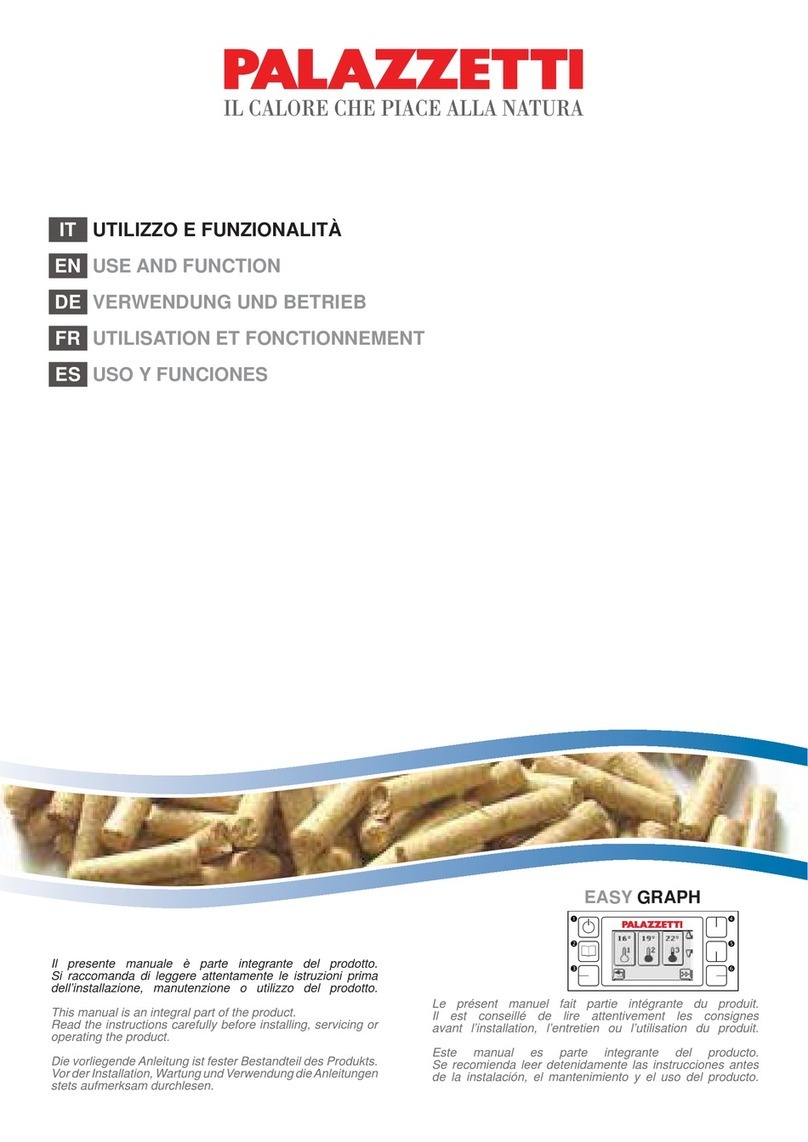
Palazzetti
Palazzetti Brian USE AND FUNCTION

Quadra-Fire
Quadra-Fire CB1200M-MBK owner's manual
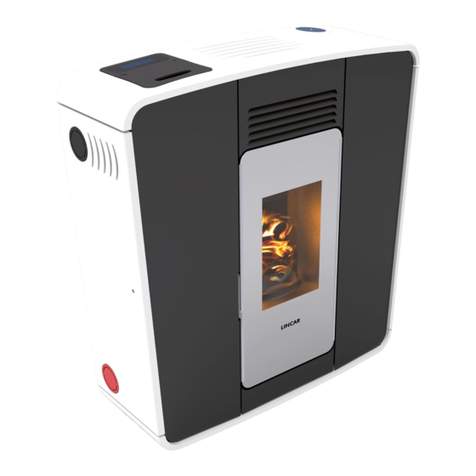
Lincar
Lincar Mya 505 Use and maintenance instructions
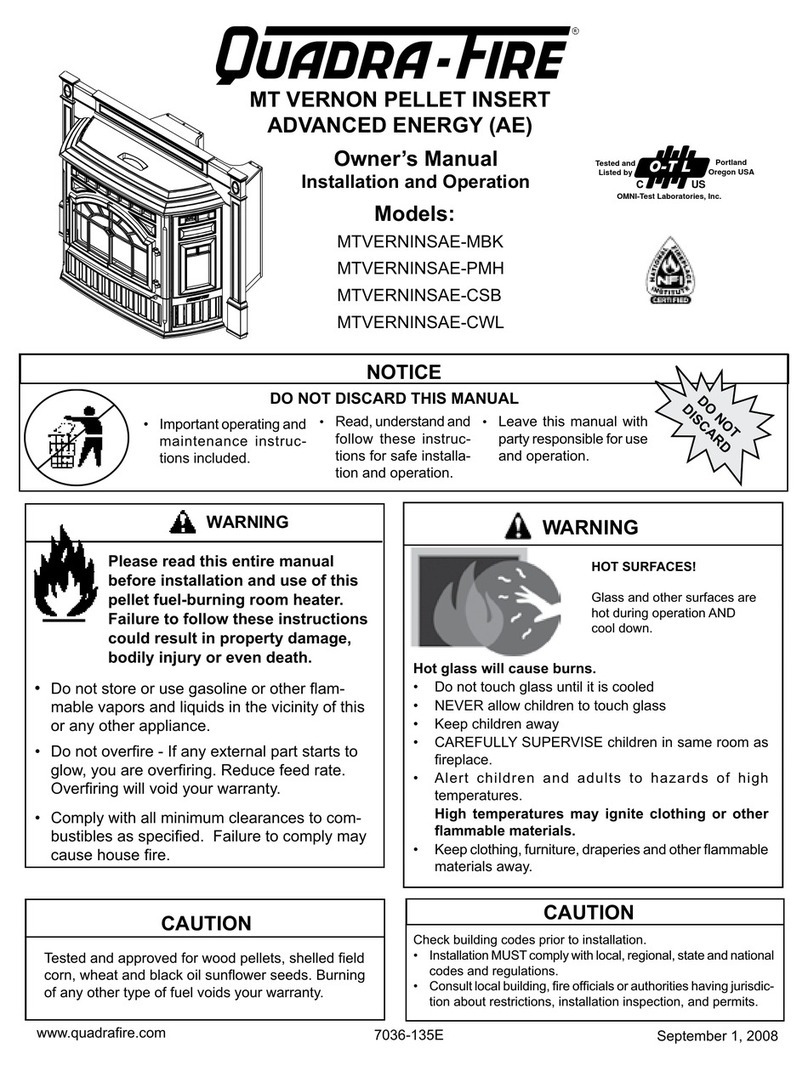
Quadra-Fire
Quadra-Fire MT VERNON Pellet Insert Advanced Energy (AE)... owner's manual
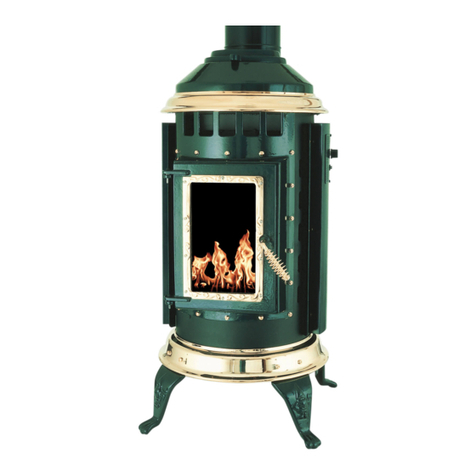
Thelin
Thelin PARLOUR 3000 owner's manual
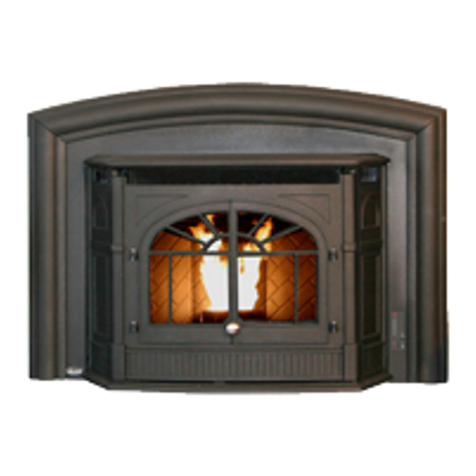
Enviro
Enviro Empress owner's manual
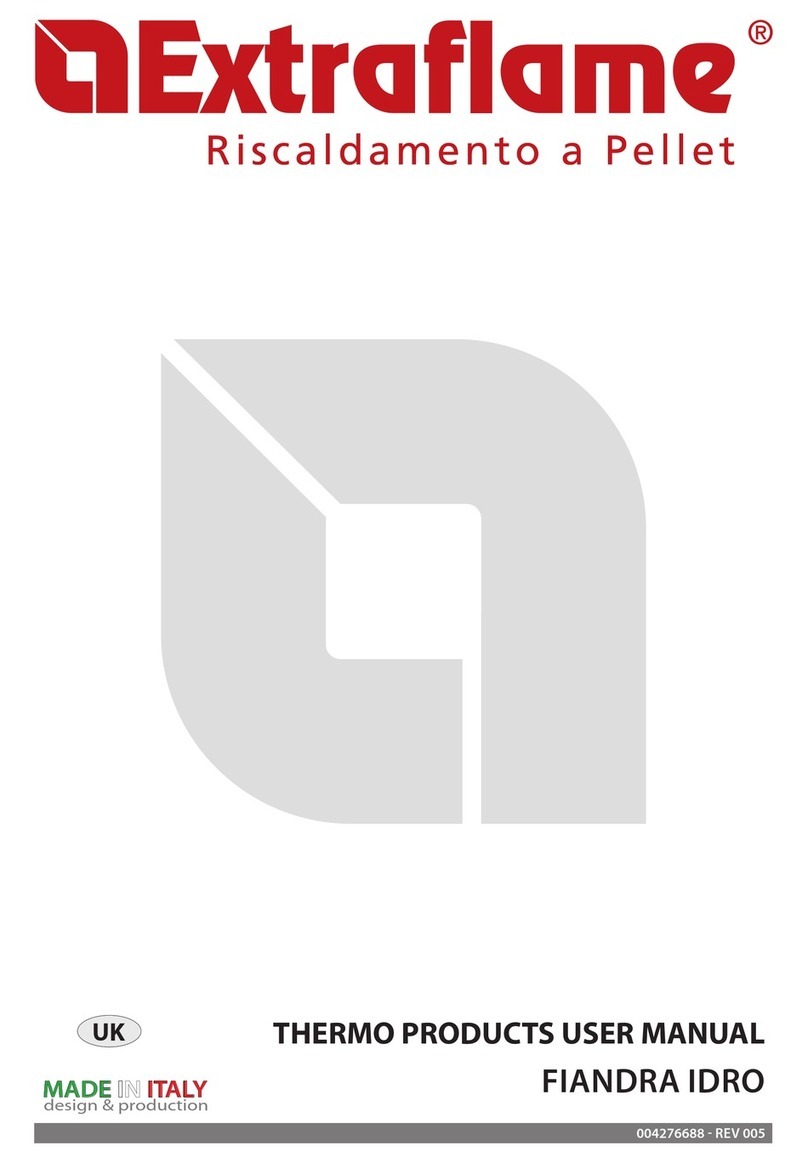
Extraflame
Extraflame FIANDRA IDRO user manual

Drolet
Drolet ECO-55 Operation manual

Harman Stove Company
Harman Stove Company Advance Installation & operating manual

Quadra-Fire
Quadra-Fire SANTA FE owner's manual

Enviro
Enviro WINDSOR owner's manual

kozy heat
kozy heat Olivia OLV-PC operating & maintenance manual
